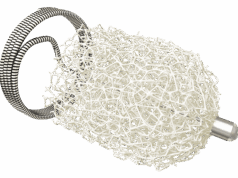
Maurizio Grosso, director, Radiology, S Croce Hospital, Cuneo, Italy, tells Interventional News about the preliminary data being collected in the Italian prostate artery embolization registry and the encouraging results being obtained with the new treatment option.
In 2015, what does the evidence say about the place of prostate artery embolization?
Currently, we can affirm that the procedure is safe and effective in the treatment of symptomatic benign prostatic hyperplasia; indeed short- and medium-term data have shown that prostate artery embolization is a promising, minimally invasive treatment option in those patient who have failed medical therapy or have reluctance to undergo surgery (transurethral resection of the prostate [TURP]). In clinical practice, this procedure should be considered to be still in its infancy; in Italy in 2014 more than 26,000 TURP procedures have been performed for benign prostatic hyperplasia but in the same period less than 100 prostate artery embolization procedures were performed.
What are the key objectives of the Italian registry on the procedure?
Italian interventional radiologists, together with urologists, have developed an Italian multicentric protocol with the objective of evaluating the use of prostatic artery embolization for the treatment of the symptomatic benign prostatic hyperplasia.
The main objectives are to evaluate the improvement of the International Prostatic Symptom Score (IPSS), the reduction of prostate volume, the prostate-specific antigen levels, the maximum urinary flow rate, the urine residual volume and the quality of life with the procedure. Another objective was to evaluate the complications related to the procedure.
What are the most interesting registry data to emerge so far?
We have only preliminary data at the moment: about 100 patients have been collected in the registry and the majority have been treated by Antonio Rampoldi’s group in Milan (more than 50 patients) and by our group in Cuneo (30 patients). Our data confirm the safety and the efficacy of the procedure. We have obtained encouraging results, both in terms of gland volume reduction and in the reduction of IPSS and improved quality of life, particularly in patients with indwelling catheters who have had these removed after the procedure. This is seen in most cases.
What are the key randomised trials directly comparing prostate artery embolization with TURP that you are watching with interest?
The only randomised trial comparing TURP vs. embolization to have been published so far is in Radiology (March 2014) by Yuan-an Gao’s group from China. The investigators randomised 114 patients (54 were treated by prostate artery embolization and 53 were treated by resection). The technical success was 94.7% and both interventions showed improvements. There were more frequent complications with embolization (p=0.029). Acute urinary retention was 25.9% and post-embolization syndrome was observed in 11.1%. There was clinical failure in 9.4% of prostate artery embolization patients.
IPSS, quality of life, peak urinary flow, and post-voiding residual urine volume showed similar improvements in both groups at six-, 12- and 24-month follow-up. Surgery showed superior improvements at one and three months.
Patient selection seems to be key with embolization. How do you identify the most suitable patients?
To obtain the best results, it is necessary to have a multidisciplinary approach involving both urologists and interventional radiologists. The clinical evaluation of patients with lower urinary tract symptoms is complex and needs proper selection, particularly to avoid treatment with prostate artery embolization in patients with bladder instability and symptoms that are not due to benign hyperplasia
In which patients would you not perform the procedure?
In our group, we exclude patients with: prostatic malignancy; occlusion of iliac artery; bladder diverticulum or stone (for whom surgery is indicated), stenosis of the urethra; detrusor failure; neurogenic bladder; and patients who are under 50 years of age.










